Hey there, Class 10 Warriors! Feeling a magnetic pull towards acing Chapter 12 of your CBSE Class 10 Science board exams? Buckle up, because we're about to crack the code on Magnetic Effects of Electric Current like nobody's business! ⚡
Forget scrambling for notes online or deciphering those dense textbooks. We've got you covered with a powerful PDF packed with clear explanations, diagrams, and tips all laser-focused on the latest 2024-25 syllabus. Whether you're a current-carrying conductor or just a curious explorer, this guide will transform your understanding of magnetic fields and leave you feeling positively charged for exam day.
So, ditch the confusion and dive into the electrifying world of magnetism. Download your free notes, master the concepts, and prepare to electrify your board scores!
Stay tuned for electrifying explanations, mind-blowing experiments, and practical tips to conquer this chapter. Get ready to crack the code and become a magnetic master of Class 10 Science!
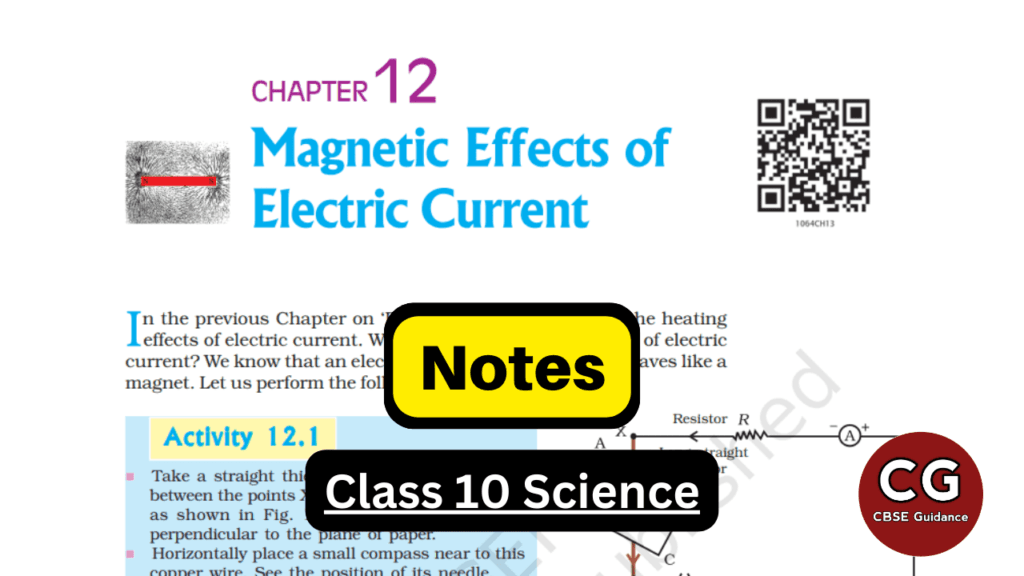
| Subject | Science (Physics) |
| Class | 10 |
| Board | CBSE & State Boards |
| Chapter No. | 12 |
| Chapter Name | Magnetic Effect of Electric Current |
| Type | Notes |
| Session | 2024-25 |
"The way to get started is to quit talking and begin doing."
- Walt Disney
Magnetic Effects of Electric Current Class 10 Notes
Table of Contents
Magnetic Field and Field Lines
Magnetic field: The region surrounding a magnet, in which the force of the magnet can be detected is called its magnetic field.
Field lines: Field lines are used to represent a magnetic field. A field line is a path along which a hypothetical free north pole would tend to move.
Magnetic field lines due to a bar magnet:
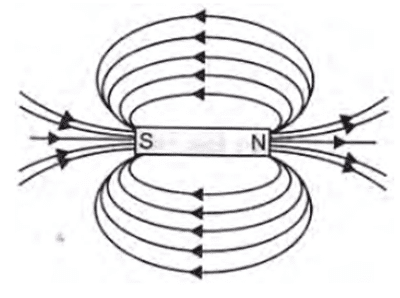
Properties of field lines:
- The magnetic field is a quantity that has both direction and magnitude.
- It is taken by convention that the field lines emerge from the north pole and merge at the south pole. Inside the magnet, the direction of field lines is from its south pole to its north pole. Thus the magnetic field lines are closed curves.
- The relative strength of the magnetic field is shown by the degree of closeness of the field lines. The closer the field lines, the stronger the strength of the magnetic field.
- No two field lines cross each other. (If they cross, it would mean that at the point of intersection, the magnetic compass needle would point toward two directions, which is not possible.
Magnetic Field due to a Current Carrying Conductor
Magnetic Field due to a Current through a Straight Conductor
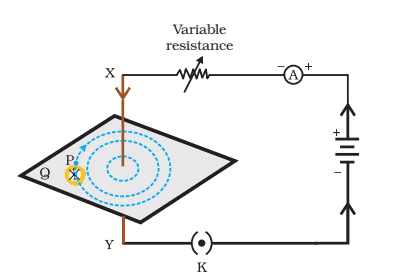
A pattern of concentric circles indicating the field lines of a magnetic field around a straight conducting wire. The arrows in the circles show the direction of the field lines.
The strength of the magnetic produced by a straight conductor carrying current depends on:
- The strength of a field is directly proportional to the current passing through the conductor.
- Strength of the field is inversely proportional to the perpendicular distance from the conductor.
Right-Hand Thumb Rule
The direction of the magnetic field produced by the current-carrying conductor can be found by applying the Right-Hand Thumb Rule. According to this rule, if we are holding a current-carrying straight conductor in our right hand such that the thumb points towards the direction of the current, then our fingers will wrap around the conductor in the direction of the field lines of the magnetic field.
Magnetic Field due to a Current through a Circular Loop
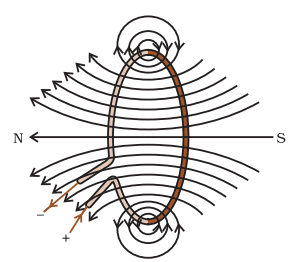
- Every point on the wire carrying current would give rise to the magnetic field appearing as straight lines at the center of the loop.
- By applying the right hand rule, it is easy to check that every section of the wire contributes to the magnetic field lines in the same direction within the loop.
- We know that the magnetic field produced by a current-carrying wire at a given point depends directly on the current passing through it. Therefore, if there is a circular coil having n turns, the field produced is n times as large as that produced by a single turn.
Magnetic Field due to a Current in a Solenoid
Solenoid: A coil of many circular turns of insulated copper wire wrapped closely in the shape of a cylinder is called a solenoid.
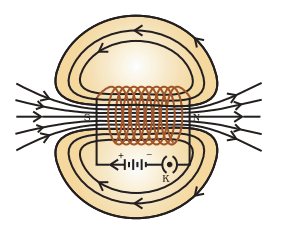
One end of the solenoid behaves as a magnetic north pole, while the other behaves as the south pole. The field lines inside the solenoid are in the form of parallel straight lines. This indicates that the magnetic field is the same at all points inside the solenoid. That is, the field is uniform inside the solenoid.
A strong magnetic field produced inside a solenoid can be used to magnetize a piece of magnetic material, like soft iron, when placed inside the coil. The magnet so formed is called an electromagnet.
The strength of a magnetic field is directly proportional to:
- The number of turns in the solenoid.
- The current in the solenoid.
Force on a Current-Carrying Conductor in a Magnetic Field
Experiment to show that force is exerted on a current-carrying conductor when placed perpendicular to a magnetic field
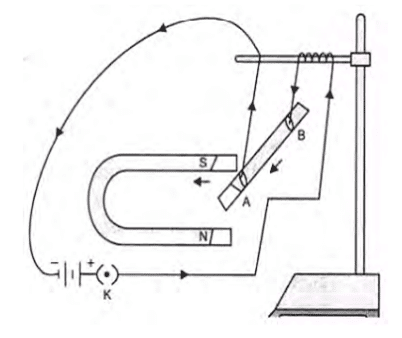
Take a small metal rod AB and suspend it from a stand with the help of two connected wires. Put the in between the horseshoe magnet in such a way that the rod remains in between the two poles. Pass the current in the rod through the two wires. You would find that the rod is deflected towards the left. Now reverse the direction of the current, and the rod is deflected in opposite direction. This show that a force is experienced by a current-carrying conductor in the magnetic field.
Factors on which Force exerted on Current carrying conductor in magnetic field depend:
- The magnitude of the force is the highest/maximum when the direction of the current is at right angles/perpendicular to the direction of the magnetic field.
- The magnitude of the force is minimum when the direction of the current is parallel to the direction of the magnetic field.
Fleming’s left-hand rule: Stretch the forefinger, the middle finger, and the thumb of the left hand mutually perpendicular to each other in such a way that the forefinger points the direction of the magnetic field, the middle finger points the direction of current (opposite to the direction of flow of electrons) then the thumb will point the direction of the force on the conductor.
Domestic Electric Circuits
The standard color code for
- Live wire – Red
- Neutral – Black
- Earth – Green
The potential difference between Live wire and Neutral wire is 220V.
Safety Measures:
i. Earthing
The metallic case of an electrical appliance is earthed because metals are good conductors of electricity and in case if current exceeds i.e., live wire touches the metallic case of an appliance, then due to earthing all the excess amount of current flows down to the earth and we prevent ourselves from an electric shock.
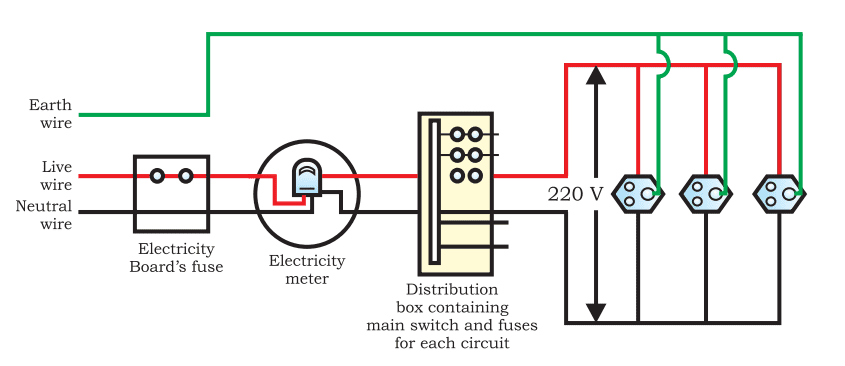
ii. Fuse
It is a safety device that protects the circuit in case excess current flows through the circuit. When a high current flows through a circuit, the fuse wire gets heated and melts. This breaks the circuit and the current stops flowing.
Overloading
- Cause: Happens when too many devices or appliances are connected to a single socket or circuit, drawing more current than the circuit is designed to handle. It can also occur when there is a sudden spike in supply voltage.
- Effect: This increased current flow heats the wires beyond their safe limit, which can cause the insulation to melt and may lead to fires.
Short-Circuiting
- Cause: Occurs when the live (positive) wire and neutral (negative) wire come into direct contact, usually due to damaged insulation or a fault in an appliance.
- Effect: Creates a path with very low resistance, causing a sudden surge in current flow that can damage appliances, wires, and pose fire risks.
Both issues are prevented by fuses or circuit breakers that stop the current flow.
Overloading can be avoided by the following methods:
- Avoid connecting too many appliances to a single socket or circuit.
- Use appliances with appropriate power ratings that match the circuit’s capacity.
- Turn off appliances when not in use to reduce unnecessary load.
- Ensure proper wiring and insulation to handle the required current.
Download Magnetic Effects of Electric Current Class 10 (Chapter 12) Class 10 NCERT Underlined PDF
| Must Read: Magnetic Effects of Electric Current Class 10 Important Questions with Answers to get an idea of the different types of questions asked from this chapter. |
| You Might Also Like: CBSE Class 10 Notes CBSE Class 10 Important Questions and Answers |
Hope you liked these notes on Class 10 Science Chapter 12 Magnetic Effects of Electric Current. Please share this with your friends and do comment if you have any doubts/suggestions to share.